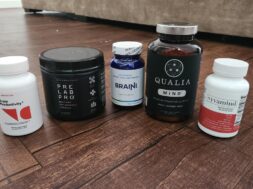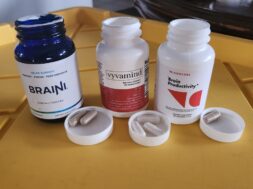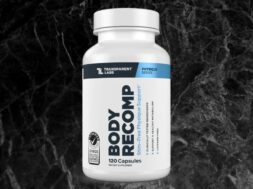
While nothing replaces sleep, good nutrition, and smart programming, some tools genuinely accelerate the process when used consistently, and one of those tools is red light therapy. Once limited to clinics and high-end wellness centers, it’s now accessible in compact, wearable forms that make it easy to recover at home.
The idea is simple: expose your muscles and joints to specific wavelengths of red and near-infrared light to enhance cellular energy, reduce inflammation, and speed up healing.
Among the dozens of devices on the market, the Hooga Red Light Therapy Belt and MitoQUAD Wavelength Belt are two of the most talked-about options. Both promise professional-grade results in a portable, hands-free format. Over the past few months, I’ve put both to the test in my own recovery routine as I integrated each into my post-training sessions and daily life.
This review breaks down how they compare in power, performance, comfort, and real-world results, helping you decide which one actually fits your goals and lifestyle.
Quick Verdict
Both belts deliver legitimate red light therapy benefits and are well-built for athletes, but they cater to slightly different needs.
The Hooga Red Light Therapy Belt is portable, wireless, and beginner-friendly. It uses proven 660nm and 850nm wavelengths and delivers noticeable relief for sore muscles and joints after consistent use. It’s simple, effective, and great value for money, making it ideal for everyday recovery, travel, or quick localized sessions.
The MitoQUAD Wavelength Belt pushes deeper into performance territory. It features four wavelengths, five intensity levels, and a dense array of 1,215 LED chips, offering stronger coverage and deeper tissue penetration. It’s a heavier, corded setup designed for dedicated home recovery sessions, especially for the lower back and core.
That said, if you want the most advanced and versatile red light therapy device overall, I’d still recommend the Kineon Move+ Pro. Its laser-LED hybrid system, modular attachments, and app-controlled precision provide better targeting and deeper therapeutic impact, particularly for chronic joint pain or tendon recovery.
| Feature | Winner |
|---|---|
| Performance & Effectiveness | Mito |
| Wavelengths | Mito |
| Design & Build Quality | Draw |
| Ease of Use | Draw |
| Battery | Mito |
| User Reviews | Draw |
| Price | Hooga |
Quick Verdict
After testing Hooga and Mito Red Light for over a month, Kineon Move+ Pro offers better value for athletes and active individuals who need targeted recovery.
The Kineon’s wearable design and dual laser/LED technology provide more precise treatment for joint-specific issues, which is crucial for anyone dealing with training-related aches and pains.
What Is the Hooga Red Light Therapy Belt?
The Hooga Red Light Therapy Belt is a lightweight, rechargeable device that delivers 660nm red and 850nm near-infrared light directly to your skin. These wavelengths are the gold standard in red light therapy research, proven to support muscle recovery, pain reduction, and skin health by stimulating cellular energy (ATP) production.
At just under a pound, the belt is flexible enough to wrap around your lower back, knees, shoulders, or quads, and the built-in auto-shutoff timer (20 minutes) makes it hassle-free. The wireless battery lasts for 4–6 sessions per charge, and recharging via USB-C takes about 2–3 hours.
Hooga has built its reputation on straightforward, science-backed products that don’t overcomplicate things. This belt fits that mold with no app, no extra settings, just an easy, portable tool that does what it promises. You can read my Hooga review for my experience.
Pros
- Clinically validated wavelengths (660nm red, 850nm near-infrared)
- Lightweight, portable, and rechargeable
- Simple one-button operation with auto shut-off
- Comfortable, flexible build for different body parts
- Affordable mid-range price ($299)
Cons
- No adjustable intensity or smart tracking
- Velcro straps may wear with frequent use
- Small coverage area; requires repositioning for larger zones
- Can get warm in longer sessions
It’s not a high-tech gadget, and that simplicity is part of its appeal.
What Is the MitoQUAD Wavelength Belt?
The MitoQUAD Wavelength Belt by Mito Red Light is a corded, medical-grade red light device built for serious users. It uses TriChip LED technology with 405 diodes with three chips each, totaling 1,215 LED chips, and covers four therapeutic wavelengths:
- 630nm & 660nm (Red Light) – boosts circulation, skin regeneration, and surface-level repair
- 810nm & 850nm (Near-Infrared) – penetrates deep into muscles, tendons, and joints
The belt’s dense LED array and five intensity levels make it one of the most powerful wearable devices available. It’s certified to IEC 60601 medical safety standards, which sets it apart from most consumer-grade devices.
While it’s not battery-powered — you need to plug it in — the MitoQUAD compensates with raw power and precision, delivering a more clinical-style experience for those who take recovery seriously. You can read my Mito Red Light Therapy review for my experience.
Pros
- Quad-wavelength design for multi-layered therapy
- 1,215 LED chips for deep, even coverage
- Five adjustable intensity levels
- Medical-grade build quality and safety certification
- Excellent for back, hip, and core recovery
Cons
- Corded (requires wall outlet)
- Heavier and less flexible for smaller joints
- No battery option or portability
- Fixed shape limits versatility
It’s a professional-level device aimed at people who value intensity and consistency over convenience.
Hooga vs Mito Red Light: Main Differences
Performance and Effectiveness
The MitoQUAD feels more like a therapeutic treatment. The quad-wavelength setup, combined with 1,215 LED chips, delivers a deep, enveloping warmth that you can feel several layers below the skin.
When I used it on my lower back after heavy squat and deadlift days, the relief was tangible — a deep “melting” sensation that reduced stiffness and helped me move more freely the next morning. Over the course of a few weeks, I noticed less morning tightness and faster recovery between sessions.
This kind of power comes from the energy density (irradiance) that the MitoQUAD can deliver thanks to its four wavelengths and sheer LED count.
It’s particularly effective for core, hip, and lower-back recovery, which makes sense given its belt design and fixed width. You can think of it as a clinical-level therapy tool tailored to a specific region rather than a general-purpose device.
The Hooga Belt, by contrast, is built for consistency and convenience rather than pure power. Because it’s wireless and easy to wear anywhere, I found myself using it far more often. That frequency matters. With red light therapy, daily exposure adds up: mitochondrial benefits, circulation improvements, and inflammation reduction compound over time.
So while the Hooga doesn’t match the raw output of the MitoQUAD, its “always-on accessibility” makes it just as valuable for people who’ll actually stick with it.
Wavelengths
The wavelength differences between these two devices are among their most defining traits.
The Hooga Belt uses 660nm (red) and 850nm (near-infrared), which is the combination that’s been validated in dozens of clinical studies for improving mitochondrial energy production (ATP), circulation, and muscle recovery.
These two wavelengths hit the “sweet spot” of red light therapy: red for surface-level effects (skin health, collagen, blood flow) and near-infrared for deeper tissues (muscle, joint, and fascia recovery).
The MitoQUAD, however, adds more sophistication by stacking four distinct wavelengths — 630nm, 660nm, 810nm, and 850nm — across the red and near-infrared spectrum. The result is a more complete light profile that engages multiple layers of tissue simultaneously.
Here’s how they differ in function:
- 630nm: Great for skin-level recovery, circulation, and anti-inflammatory benefits.
- 660nm: Stimulates mitochondrial function in shallow tissues.
- 810nm: Penetrates more deeply than 660nm and interacts strongly with cytochrome c oxidase, the enzyme responsible for cellular energy production.
- 850nm: Goes even deeper, affecting joints, connective tissue, and potentially even bone.
Theoretically, this combination creates a cascade effect: surface healing, muscle restoration, and deep-tissue repair all activated in one session. In practice, I found it makes the MitoQUAD feel more “complete,” particularly for areas like the lower back where multiple tissue layers are involved.
However, the tradeoff is simplicity vs. precision. The Hooga’s dual-wavelength setup is perfectly calibrated for common athletic recovery needs. The MitoQUAD’s four-band spectrum might offer slightly broader benefits, but only if you’re using it consistently and on body parts that can benefit from the full depth of penetration.
Design and Build Quality
The Hooga Belt is light, flexible, and straightforward, and feels like performance gear. The outer material is soft but durable, designed to contour around your body without pinching or overheating. It’s comfortable enough to wear while walking around or working at a desk. The LED panel is well-integrated and evenly illuminated, which prevents hotspots or uneven exposure.
That said, after several weeks of daily use, the Velcro fasteners started showing mild wear. It’s not a deal-breaker, but frequent users may eventually need replacement straps to maintain tightness. The heat buildup is mild and soothing, but in warmer climates or long sessions, it can get noticeable.
The MitoQUAD, on the other hand, is engineered with a medical aesthetic. The silicone body feels heavier and denser. The five-level intensity controller is neatly integrated into the belt, giving it a professional look and avoiding the loose control-box issue that plagues cheaper devices.
The LED panel itself flexes moderately but retains its shape, ensuring consistent light distribution across the treatment area.
Because of its IEC 60601 certification, the MitoQUAD is built to withstand long-term, high-intensity operation without overheating or losing output. It’s clearly meant to feel like a piece of medical equipment, not a consumer gadget.
Ease of Use
The Hooga Belt wins here without question. Its single-button operation, auto-shutoff timer, and wireless design make it one of the most accessible red light devices on the market. It’s the kind of tool you’ll actually use daily because it takes almost zero mental energy.
It’s particularly valuable for those who already have busy schedules, like parents, professionals, or athletes, who don’t have time to sit still for 20 minutes. The ability to move freely during sessions made it easy for me to use consistently throughout the week.
The MitoQUAD, while straightforward, is more of a “sit down and recover” device. The five-level control gives you customization, but it requires a bit more setup, including plugging in, adjusting intensity, and staying close to a wall outlet.
You can’t multitask as easily, which means you’ll need to deliberately carve out time for sessions. That’s not necessarily bad, as it encourages mindful recovery, but it’s less flexible for daily life
Battery Life and Hardware
The Hooga prioritizes freedom. With 4–6 sessions per full charge and a 2–3 hour recharge time, it’s built to go anywhere. I often used it between coaching sessions or while working at my desk, something that wouldn’t be possible with a wall-powered device. The USB-C port is a nice touch, and the internal battery maintained consistent output even after multiple charging cycles.
The MitoQUAD, in contrast, is built for continuous, high-output performance. It’s AC-powered only, but that means it can sustain full intensity indefinitely without dimming or recharging. The hardware feels rock-solid, with excellent heat dissipation and power management.
There’s no question that MitoQUAD delivers more energy per session, but Hooga wins where convenience matters most.
Price
| Device | Price | Wavelengths | Power Source | Key Strength |
|---|---|---|---|---|
| Hooga Red Light Therapy Belt | $299 | 660nm & 850nm | Rechargeable (wireless) | Portable, simple, effective |
| MitoQUAD Wavelength Belt | $350 | 630nm, 660nm, 810nm, 850nm | AC power (corded) | Strong output, medical-grade quality |
Both sit in the mid-range of red light devices — far cheaper than full-body panels or laser systems, but powerful enough for therapeutic results.
My Experience With The Hooga Red Light and MitoQUAD Belts
I tested these devices in separate training cycles, giving each several weeks of consistent use in my post-workout recovery routine.
Hooga Red Light Therapy Belt – Everyday Portability
The Hooga became part of my daily rhythm. After intense squat or grappling sessions, I’d strap it around my lower back or knees for 15–20 minutes while answering emails or prepping meals.
Within the first week, I noticed less lingering soreness in my knees and faster recovery between sessions. After heavy lifting days, that deep stiffness that usually hung around in my quads eased noticeably. The warm, soothing feel during sessions was relaxing, and over time, I even noticed subtle improvements in skin texture around my elbows, likely from the 660nm wavelength’s effect on circulation and collagen.
After a month of near-daily use, the difference in recovery was clear enough that I kept the belt as a regular part of my post-training protocol. My only complaints were the lack of adjustable intensity and the Velcro showing minor wear by week four.
MitoQUAD Wavelength Belt – Focused Power
A few weeks later, I switched to testing the MitoQUAD Belt, integrating it into my heavier lifting cycle. I used it primarily on my lower back and hips, which tend to tighten up after clean and jerk sessions.
The power difference was obvious right away. Even at mid-intensity, the deep penetrating warmth reached into muscle tissue, relaxing stiffness and improving mobility the next morning. After about ten days of consistent use, I was waking up looser, with noticeably less post-training tension.
It’s a more powerful, stationary experience, not something you wear while moving around the house. But if you dedicate 15–20 minutes per day, it feels close to clinical-level therapy.
To summarize, both delivered results, just at different levels of commitment.
Should You Buy Hooga or MitoQUAD?
If your goal is simple, consistent recovery support, the Hooga Belt is the clear choice. It’s affordable, wireless, and easy to integrate into daily life, making it perfect for athletes, busy professionals, or anyone looking to recover faster without complicating their routine.
If you’re after maximum therapeutic intensity, particularly for chronic lower-back or hip pain, the MitoQUAD delivers a stronger punch. It’s better suited for serious users willing to sit still during their sessions.
But if you’re ready to invest in a premium, do-it-all system, the Kineon Move+ Pro still leads the pack. Its 808nm laser integration, modular design, and app customization give it a level of precision that neither the Hooga nor the MitoQUAD can match.
Kineon MOVE+ Pro
Kineon MOVE+ Pro
Powerful red light therapy device designed be applied without having to sit in front of a large light panel.
CHECK CURRENT DEALS











